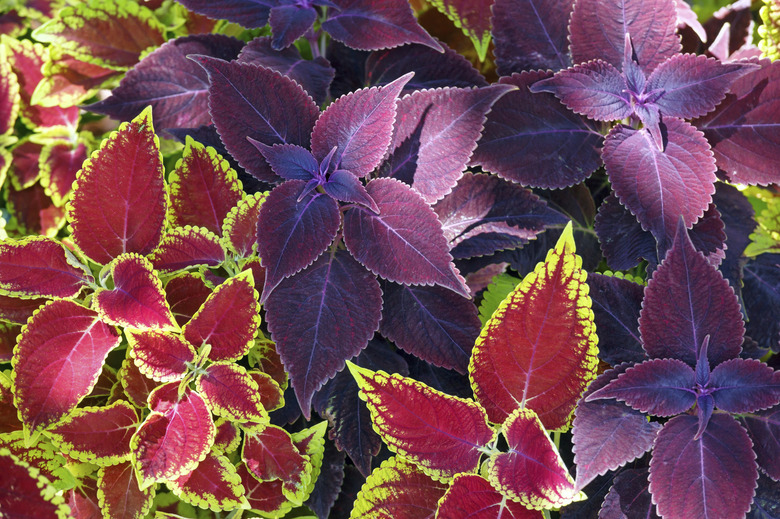Coleus Varieties
Grow coleus for its brightly colored leaves, not its tiny flowers. A tropical plant, coleus potentially grows as a perennial in U.S. Department of Agriculture plant hardiness zones 10 and 11, but is more often treated as an annual or grown as a houseplant. Easy to care for and durable, choose a coleus that will work best for you and where you plan to grow it.
Step 1
Most varieties of coleus prefer part shade, but several tolerate full sun. With fringed, ruby red leaves edged with a layer of dark bronze and a fine line of chartreuse "Red Ruffles" (Solenostemon scutellarioides "Red Ruffles") makes a stunning display as a garden or container plant paired with another variety of contrasting color. Although red leaves generally indicate sun tolerance among coleus varieties, there are exceptions. "The Line" (Solenostemon scutellarioides "The Line") coleus, for example, thrives in full sun and has chartreuse leaves marked with line of deep purple down the center.
Coleus for Shade
Step 1
One coleus variety that grows well in full shade is "Brown Sugar Drop" (Solenostemon scutellarioides "Brown Sugar Drop"), which has small, heart-shaped maroon leaves edged in bright green. Another shade-loving variety "Black Magic" (Solenostemon scutellarioides "Black Magic") has similar colors to "Brown Sugar Drop" but has larger leaves and can grow 3 feet tall. "Black Dragon" (Solenostemon scutellarioides "Black Dragon") also prefers shade and offers textural contrast with purple-black scalloped leaves and green stems.
Step 2
- Most varieties of coleus prefer part shade, but several tolerate full sun.
- The Line" (Solenostemon scutellarioides "The Line") coleus, for example, thrives in full sun and has chartreuse leaves marked with line of deep purple down the center.
Coleus for Containers
Step 1
Most coleus grow well in a containers. Using containers makes it easy to move the plants indoors for winter. Certain varieties make excellent displays in window boxes, hanging baskets or urns, especially in shady areas where color is usually scarce. One example of a trailing variety of coleus is "Lava Rose" (Solenostemon scutellarioides "Lava Rose"), a compact plant that sports rose and burgundy-colored, scalloped leaves with green edging. "Trailing Salamander" (Solenostemon scutellarioides "Trailing Salamander" is an eye-catching, shade-loving, trailing coleus with lobed green leaves with deep maroon centers. For sunny spots, consider "Strawberry Drop" (Solenostemon scutellarioides "Strawberry Drop"), named for its heart-shaped green leaves with strawberry pink and cream centers.
Dwarf Coleus
Step 1
Dwarf varieties of coleus are suitable for containers or for use as garden border plants because they tend to grow in compact mounds. With deeply lobed leaves of green, burgundy and cream, "Mint Mocha" (Solenostemon scutellarioides "Mint Mocha") is a striking looking dwarf coleus with ferny leaves. The feathery appearance is even more pronounced in "Stained Glassworks Kiwi Fern" (Solenostemon scutellarioides "Stained Glassworks Kiwi Fern"), which has long and narrow lobed leaves of deep burgundy edged in chartreuse. For a refreshing contrast, try "Lifelime" dwarf coleus (Solenostemon scutellarioides "Lifelime"), which has bright lime green leaves.
Step 2
- Most coleus grow well in a containers.
- Dwarf varieties of coleus are suitable for containers or for use as garden border plants because they tend to grow in compact mounds.
- With deeply lobed leaves of green, burgundy and cream, "Mint Mocha" (Solenostemon scutellarioides "Mint Mocha") is a striking looking dwarf coleus with ferny leaves.
Tree Form Coleus
Step 1
With careful pruning, you can train almost any variety of coleus to grow like a tree, which is technically called a coleus standard. Larger "trees" or topiaries can be created from coleus varieties that will reach 3 to 4 feet tall, such as red-leafed "Defiant" (Solenostemon scutellarioides "Defiant") or "Saturn" (Solenostemon scutellarioides "Saturn") with bright green leaves edged in burgundy. For smaller standards of 2 to 3 feet, consider burgundy and green "Inky Fingers" (Solenostemon scutellarioides "Inky Fingers") or "Tilt-a-Whirl" (Solenostemon scutellarioides "Tilt-a-Whirl") with ruffled red leaved with green bands down the center.
References
- Cornell University: Coleus
- Missouri Botanical Garden: Solenostemon Scutellarioides
- Fine Gardening: Coleus
- Fine Gardening: Solenostemon scutellarioides "Ruby Ruffles"
- Wasco Nursery: Solenostemon scutellarioides "The Line"
- Simply Beautiful Gardens: Lava Rose Coleus
- Four Star Greenhouse: Strawberry Drop
